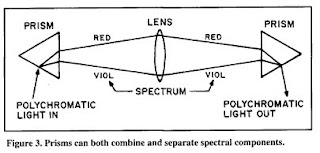Multiplexing is the process where multiple channels are combined for transmission over a common transmission path.
There are two types of multiplexing techniques:-
- FDM (Frequency Division Mux)
- TDM (Time Division MUX)
WDM: Wavelength Division Multiplex and Multiplexer
"Wavelength Division Multiplexing (WDM) is a technique that multiple signals are carried together as separate wavelengths (color) of light in a multiplexed signal".
WDM is used in optical fiber networks. WDM and FDM (Frequency Division multiplex) are both based on the same principles but WDM applies to wavelengths of light in optical fiber while FDM is used in electrical analog transmission. A WDM optical system using a diffraction grating is completely passive, unlike electrical FDM, and thus is highly reliable. Further, a carrier wave of each WDM optical channel is higher than that of an FDM channel by a million times in frequency (THz versus MHz).
Wavelength Division Multiplexer is a device that combines optical signals from multiple different single-wavelength end devices onto a single fiber. Wavelength Division Multiplexer carries two to four wavelengths per fiber. The original WDM systems were dual-channel 1310/1550 nm systems. Typically, the same device can also perform the reverse process with the same WDM techniques: de-compose the data stream with multiple wavelength into multiple single wavelength data streams, a process call De-multiplexing. Therefore, it is very often a Wavelength Division Multiplexer and De-multiplexer are in the same box.Click the picture to enlarge.

Time division multiplexing samples a number of different information channels sequentially for transmission on a single carrier. Frequency division multiplexing generally involves summing a multitude of independent sub-carrier frequencies, each with its retinue of modulation sidebands. In polarization division multiplexing, two different information signals are modulated onto carriers of the same frequency, which are propagated with their electrostatic fields oriented orthogonally. Wavelength division multiplexing incorporates independently modulated carriers of different frequencies sharing a common transmission medium. It is this latter technique to which the present study directs itself.
Figure 1 depicts a traditional fiber optic wavelength division multiplexing scheme. Three infrared sources (lasers or light emitting diodes-LEDs) of different wavelengths are modulated independently with their respective channel intelligence. Although any number of optical carrier frequencies might be used, common practice is to generate carriers at wavelengths typically near 850, 1300, and 1550 nm.
As you can see in Figure 2,3 these wavelengths represent low loss windows for typical single-mode glass fiber. Optical star couplers combine the three modulated carriers onto a single glass or plastic light pipe. At the receive end of the fiber, couplers split the output beam into three identical components, each containing elements of all three signals. Bandpass filters at the coupler outputs let each of three photo detectors "see" and respond to a single carrier frequency. De-multiplexing could be achieved as readily using wavelength selective couplers.



No comments:
Post a Comment